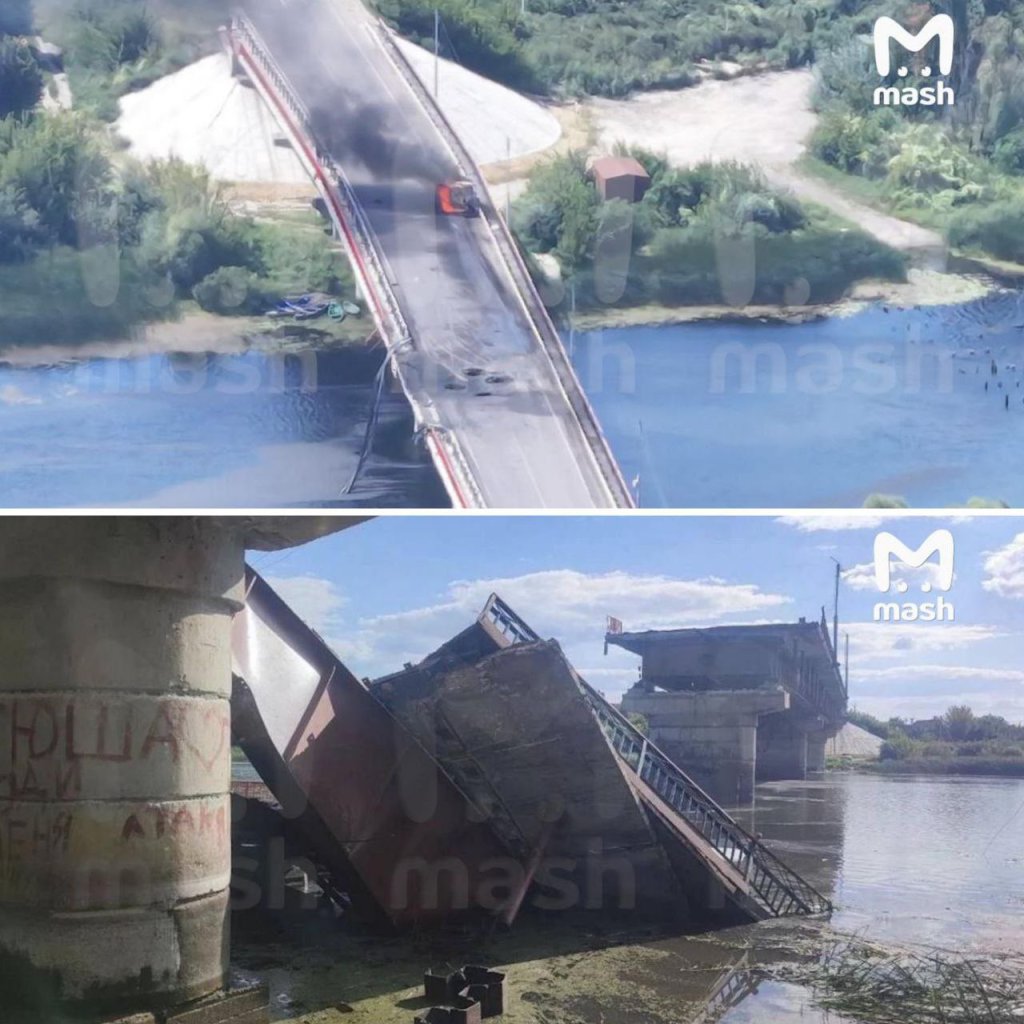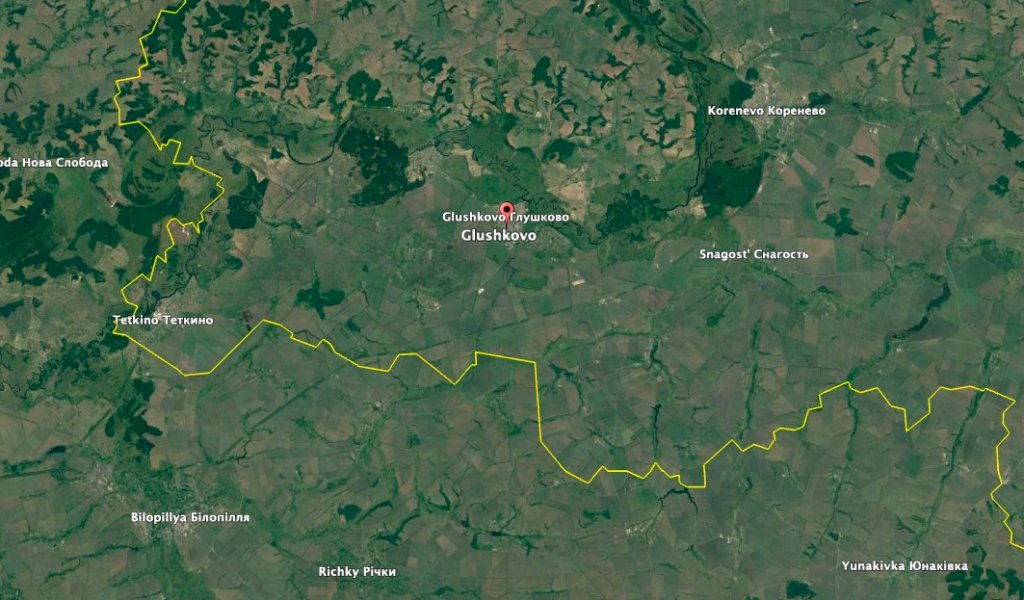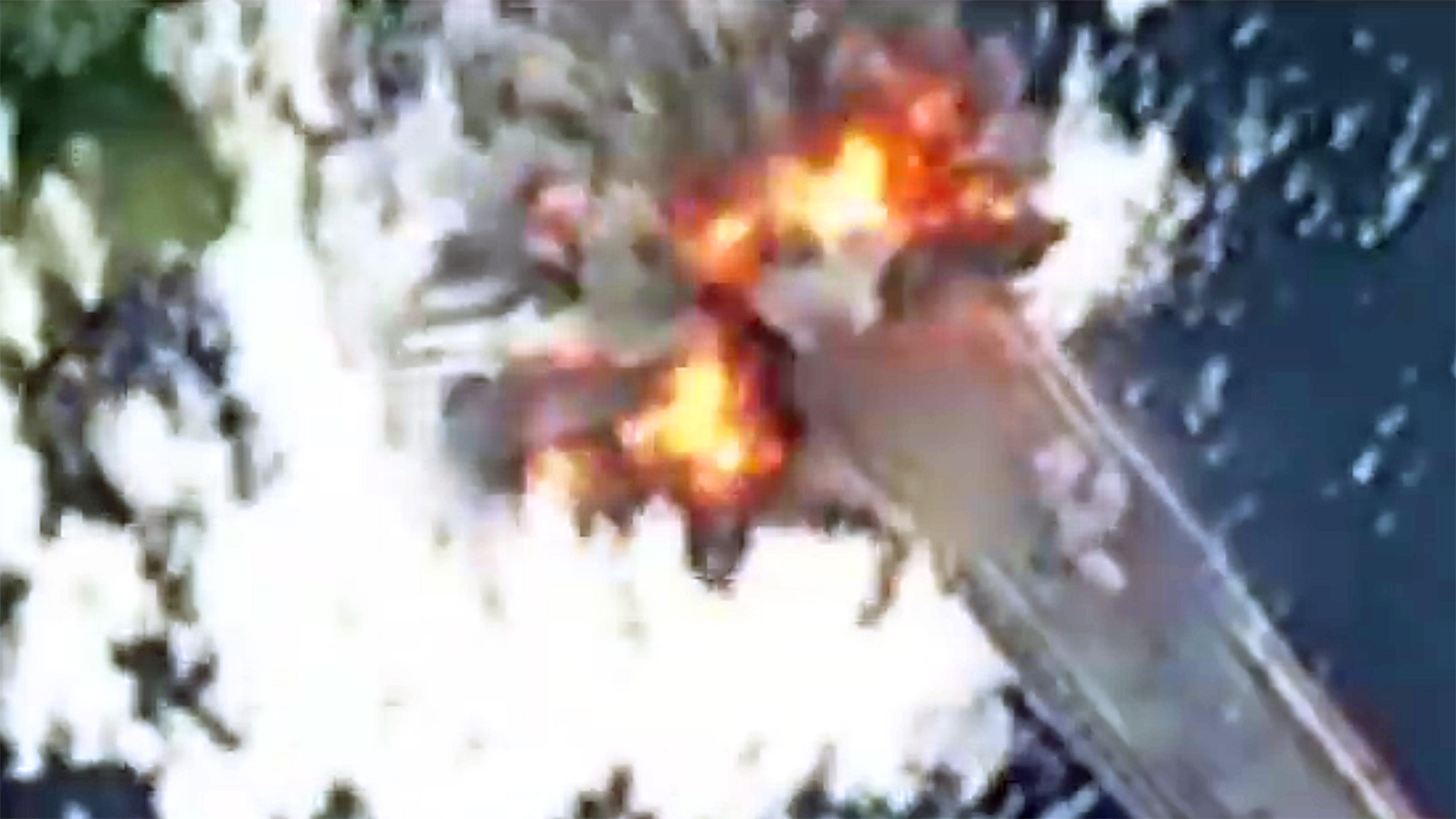Ukraine destroyed a key bridge over the Seim River in Kursk Oblast in what could be a big logistical blow for Russian forces on the 11th day of the invasion.
The Ukrainian Air Force posted a video on social media showing the moment of impact, with a whole section collapsing into the river. JDAM-ER or Hammer standoff guided bombs were likely used to finally take down the bridge. The effects seen are too intense to have been from a GMLRS guided rocket fired by a HIMARS or M270 system, although a unitary warhead ATACMS would be capable of it.
“Air Force aviation takes an active part in combat operations in the Kursk direction,” the Ukrainian Air Force said in a Telegram message accompanying the video, which you can see below. “Ukrainian pilots hit enemy strongholds, accumulations of equipment, as well as logistics centers and enemy supply routes with high-precision strikes. Thanks to the pilots and everyone who ensures the combat work of aviation!”
Earlier, Russian media and milbloggers claimed the bridge was struck by two volleys of HIMARS rockets. They showed a section of the bridge near the town of Glushkov damaged with a burning vehicle on it and then fully collapsed into the water. It is located about seven miles north of the border.

The Seim River snakes around a large section of this part of Kursk, and continues into Ukraine. The bridge in Glushkov is one of three in the area, but the furthest to the east, less than 10 miles from Ukrainian-held territory. Its destruction could be a large blow to Russian efforts to supply the area.

“Part of the Glushkov district is now cut off,” the Russian MASH news outlet explained on Telegram. “This is Tetkino, Popovo-Lezhachi, Volfino and about 27 more settlements. The civilian population can now only be evacuated by water.”
The bridge across the Seim is the main route for delivering ammunition and food for the Russian group in this area, according to Russian media.
The Russians however appear to be building pontoon bridges across the river to bring in supplies, however that could also easily be targeted by HIMARS and standoff air strikes.
Destroying the bridge is a sign that Ukraine seeks to capture the Glushkov district, Russian milbloggers said.
“In a rough approximation, the Ukrainian Armed Forces currently have three plans for the near future,” for the area, the Russian MiG of Russia Telegram channel posited last week. “If it goes well,” Ukrainian forces will “take fire control of the E38 highway in the Glushkov-Kursk section, possibly striking from the Glushkhov side as well.”
The E38, about 15 miles north of Glushkov, is an important east-west artery in the middle of Kursk Oblast.
“If it doesn’t go well,” Ukraine could “bite off a piece, occupying the heights on the bank of the Seim, and digging in…for further bargaining,” MiG of Russia suggested. “A direct attack on the nuclear power plant is extremely unlikely and makes no political sense. The movement towards Kursk has a certain military-political meaning for the enemy, but it requires time for regrouping and large forces, so it is also not particularly likely.”
This is at least the third known attempt by Ukraine to destroy the bridge. It was struck yesterday by U.S.-donated M142 High Mobility Artillery Rocket Systems, or HIMARS-launched guided rockets but damaged, not destroyed, and again on Aug. 13 as well.
The Russian Defense Ministry (MoD) posted video showing what it claims was the destruction of two more HIMARS in Ukraine Sumy Oblast, bordering Kursk.
The MoD said the HIMARS had “delivered strikes at Kursk region” and “were destroyed near Miropolye,” a town in Sumy. It is located about 2.5 miles from the border and about 35 miles from the bridge, though it is unknown at the moment from where it was attacked.
“Two missile strikes hit the positions of the U.S.-made HIMARS MLRS launchers. As a result, two HIMARS MLRS, a transport-loading vehicle, and two ammunition packages (12 rocket-propelled projectiles) were destroyed,” the MoD claimed on Telegram. “The footage shows explosions, detonation of ammunition, ignition, and a rocket projectile leaving the system.”
Yesterday, Russia released video purporting to be another HIMARS destroyed in Sumy. We cannot independently verify these claims and reached out to the Pentagon for further details.
The Russian MoD made no mention of the bridge in its latest assessment but again claimed that it was thwarting the invasion.
“Active actions of Sever Group of Forces’ units, unmanned aerial vehicles, and artillery strikes repelled an attack launched by assault detachments of the AFU 82nd Air Assault Brigade near Russkoye Porechnoye,” the MoD claimed on Telegram.
“One attack launched by the enemy’s assault detachment supported by five armored fighting vehicles through the State Border in the direction of Gorgeyevka was repelled,” the MoD stated. “Army Aviation, unmanned aerial vehicles, and artillery fire eliminated the enemy’s mobile groups attempting to get to the depth of the Russian territory one kilometer west of Anastasiyevka and 1.5 kilometers southeast of Kauchuk.”
The MoD also said it inflicted damage to personnel and equipment assigned to Ukraine’s 22nd and 61st Mechanized Brigades, 95th Air Assault Brigade, and 129th Territorial Defence Brigade near Aleksandriya, Snagost, Mirnoye, Kazachiya Loknya, Korenevo, Plekhovo, and Pushkarnoye.
Meanwhile, a CNN reporter near the border with Kursk showcased Ukraine’s ability to pour troops into that region.
Ukrainian troops have advanced one to three kilometers deeper into Kursk, Col.-Gen. Oleksandr Syrskyi told President Volodymr Zelensky, according to a tweet from the Hromadke news outlet.
“The army is provided with everything and the logistics system is working smoothly,” he said. “Meanwhile, Eduard Moskalyov, the newly appointed head of the military commandant’s office in the controlled territories of Kursk Oblast, has already begun his duties.”
In his latest situation report, Zelensky also highlighted the increasingly tense situation in the Donbas.
“Report from Commander-in-Chief [Oledkandr] Syrskyi. The frontline remains our top priority, particularly the Pokrovsk and Toretsk directions,” he said on social media. “The Kursk region operation—we are strengthening our positions and replenishing the ‘exchange fund’ for Ukraine. I am grateful to each of our warriors.”
Pokrovsk and Toretsk may be priorities, but they are increasingly in danger of falling to Russia. However, the situation in Donetsk Oblast is becoming increasingly difficult for Ukraine under tremendous Russian pressure.
Russian troops are closing in on Pokrovsk, a key Ukrainian logistics hub, The New York Times reported, citing open-source battlefield maps, “casting doubts on Ukraine’s hopes that its new offensive into western Russia will prompt Moscow to scale back its attacks elsewhere on the battlefield.”
“After capturing several villages in the area and pushing along a railway line, Russian forces are now about eight miles from Pokrovsk, one of Ukraine’s main defensive strongholds in the Donetsk region, according to the maps, which are based on combat footage and satellite images.”
Capturing Pokrovosk would bring Russia “a step closer to its long-held goal of seizing the entire Donetsk region, much of which it already controls. Pokrovsk, a city with a prewar population of about 60,000, sits on a key road linking several cities that form a defensive arc protecting the part of Donetsk that is still held by Ukraine.”
Hromadske provided some insights into how Russia was able to advance so quickly toward Pokrovsk.
“They have more ammunition, more people,” Mykhailo, a soldier of the 68th separate brigade, who “briefly but meaningfully explains the reasons for the rapid advances,” the outlet reported on YouTube.

“Russian forces continue to pursue a tactical encirclement of Ukrainian forces southeast of Pokrovsk and recently made confirmed advances in the area, the Institute for the Study of War said in its most recent assessment. “A Ukrainian soldier operating in the Pokrovsk direction stated on August 15 that Russian forces have a 10-to-1 infantry advantage in the area and conduct infantry-led assaults from just before sunrise to just after sunset each day. Another Ukrainian soldier stated that Russian forces are fewer than six kilometers from Selydove (southeast of Pokrovsk), which is consistent with ISW’s assessment of Russian advances in the area.”
As Russian troops approach, Serhiy Dobryak, the head of the regional administration urged residents “not to delay the decision to evacuate,” Special attention was paid to families with children and the elderly.”
“The enemy is advancing at a fast pace, time to collect personal belongings and leave for safer regions is getting less and less every day,” he said on Telegram. “Evacuation is the only chance to save yourself and your loved ones!”
Dobryak added that an additional train is being scheduled to take residents out of Pokrovsk tomorrow.

As people flee Pokrovsk, the Ukrainian 80th Airborne Brigade offered some more positive optics, releasing a video today of its surprise Aug. 6 attack on the Sudzha border checkpoint in Kursk. The assault was part of the first day of Ukraine’s invasion of Russia.
The 105-second video opens with a drone’s view of the attack, showing the heavily damaged checkpoint building smoking after being struck. It then cuts to a Ukrainian T-64BV tank firing direct shots at the building. A drone then provides a closer view of Russian troops emerging from the rubble, looking up and waving white clothes, indicating they wanted to surrender.
“More than 50 captured Russians in the Kursk region, the border checkpoint has been destroyed and the defense line of the enemy has been broken,” the 80th Airborne Brigade said on its Facebook page Friday. “These are the results of the Galician paratroopers after the first hours of the military operation in Kursk.”

Elsewhere on the battlefields of Ukraine, the Russian MoD claims it foiled a large-scale attack on the Kerch Bridge.
“Tonight, air defense units repelled a group strike by 12 U.S.-produced [Army Tactical Missile System (ATACMS) short-range ballistic missiles] launched at the Crimean Bridge,” the MoD claimed on Telegram. “All missiles were destroyed.”
The War Zone cannot independently verify the claim as to what Ukrainian weapons were used, if any at all.
Ukraine will likely hit the bridge again, one prominent Russian milblogger suggested.
“A week after the last massive raid on the border and rear regions, Crimea was again subjected to a combined attack,” the Kremlin-connected Rybar Telegram channel wrote. Rybar postulated that because ”for the first time in a very long period of time, target designation was carried out by an American MQ-9 Reaper drone from the Black Sea, further attempts by the Ukrainian Armed Forces to damage the bridge should be expected.”
This makes no sense as the MQ-9 would have no need to designate the bridge for ATACMs and considering it is a static thoroughly known target.
The bridge, Vladimir Putin’s prized $4 billion span linking Russia with occupied Crimea, has already been damaged twice by Ukrainian attacks.
Ukraine’s spy boss vowed to us that the bridge will ultimately be destroyed.
“It’s not a question of will we strike or won’t we strike,” Lt. Gen. Kyrylo Budanov told us in an exclusive interview last September. “We’re doing that regularly so we will finish it. It’s just an issue of time.”
In another part of Crimea, the Russians are apparently trying to fool Ukrainian targeteers, according to our friend and naval undersea warfare expert H. I. Sutton. They developed a decoy of a Kilo class submarine and placed it in Sevastopol harbor, next to the Russian Navy Improved Kilo class diesel-electric attack submarine Rostov-on-Don. Ukraine claims it destroyed that boat earlier this month in an attack on Sevastopol “by units of the missile forces, in cooperation with units of the Naval Forces of the Armed Forces of Ukraine.”
Sutton, who uses the Twitter handle @CovertShores, shared some satellite imagery discovered by open-source investigators showing the fake submarine, which you can see below.
The video below shows Ukrainian drones hunting down a Russian armored personnel carrier. It does not go well for the Russians.
Drone-dropped munitions keep getting bigger. Ukraine’s Steel Hornets unit reportedly made one weighing in at a robust 95 pounds. Called “Fat Man,” it apparently has an explosively formed penetrator (EFP) warhead.
Kyiv’s forces are using chainsaw chains to add a fragmentation effect to its first-person view (FPV) drone munitions.
That’s it for now.
Contact the author: howard@thewarzone.com
